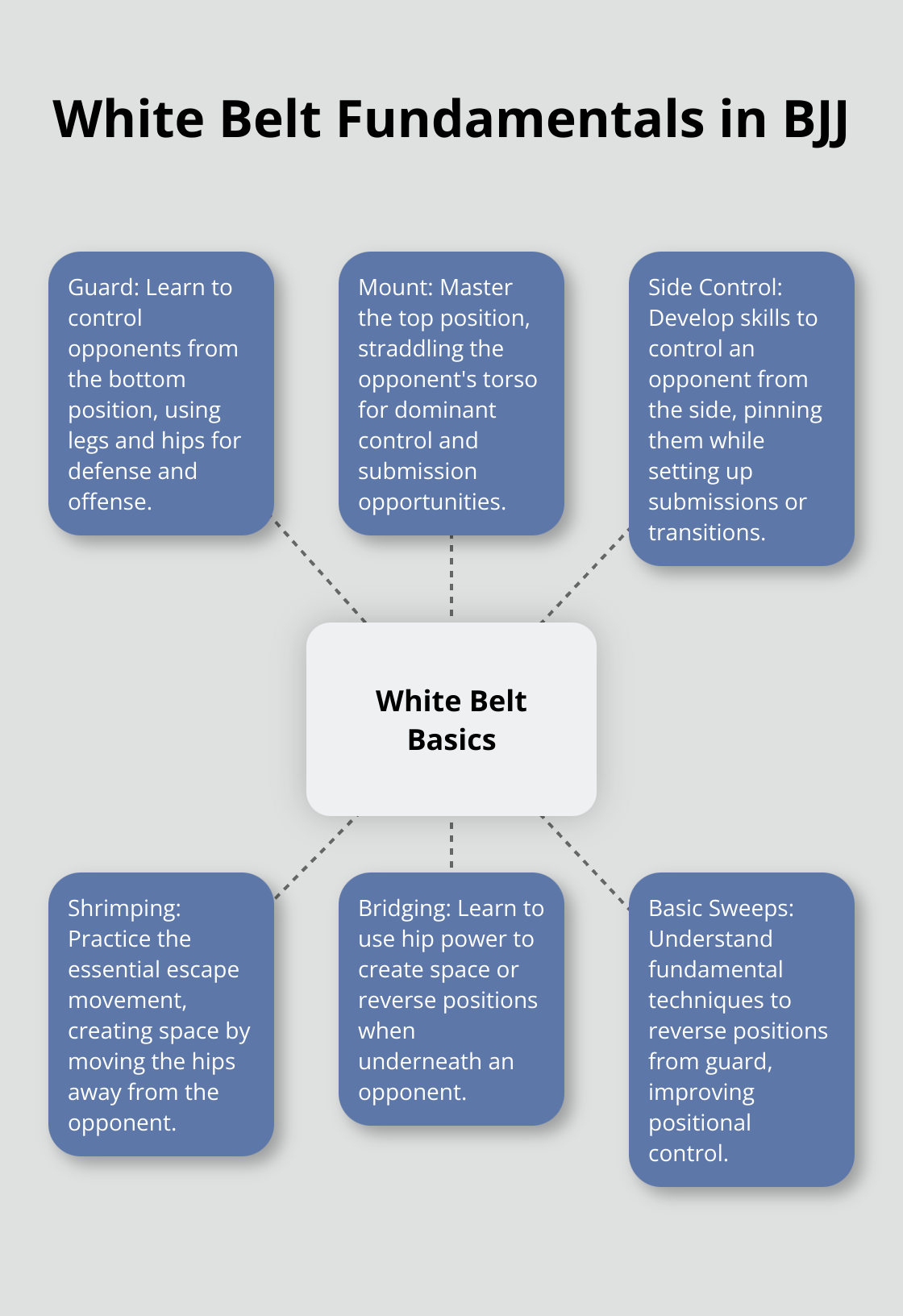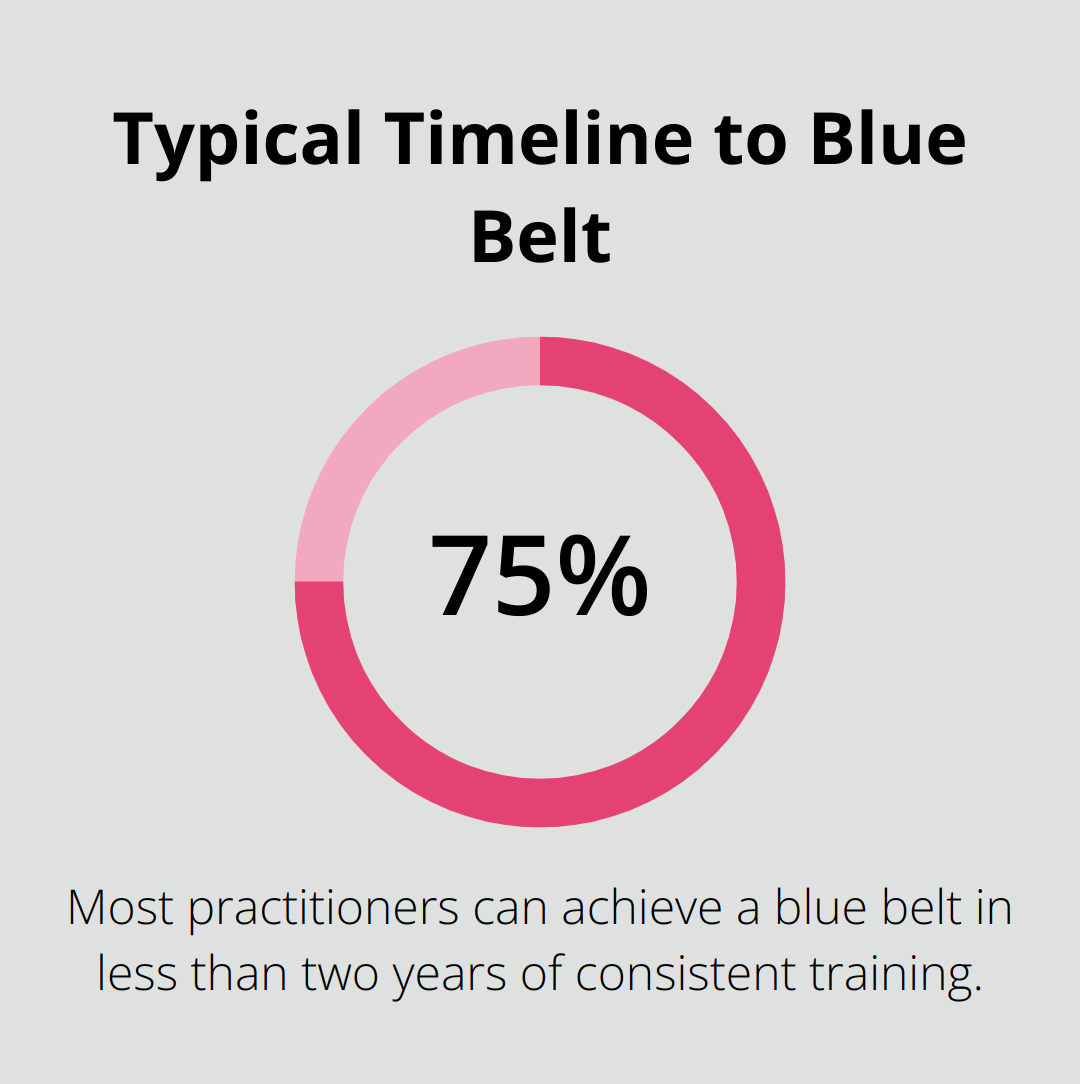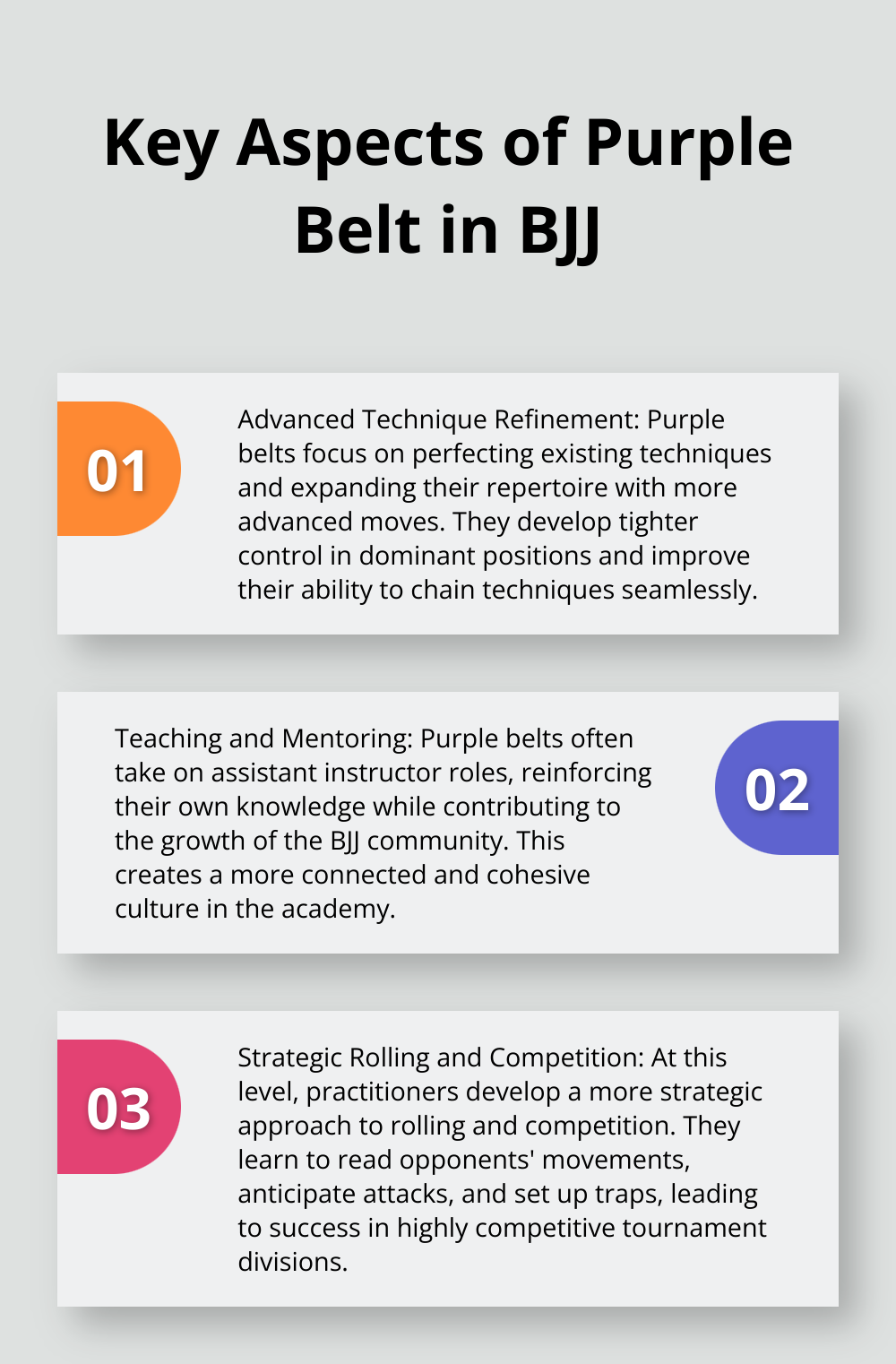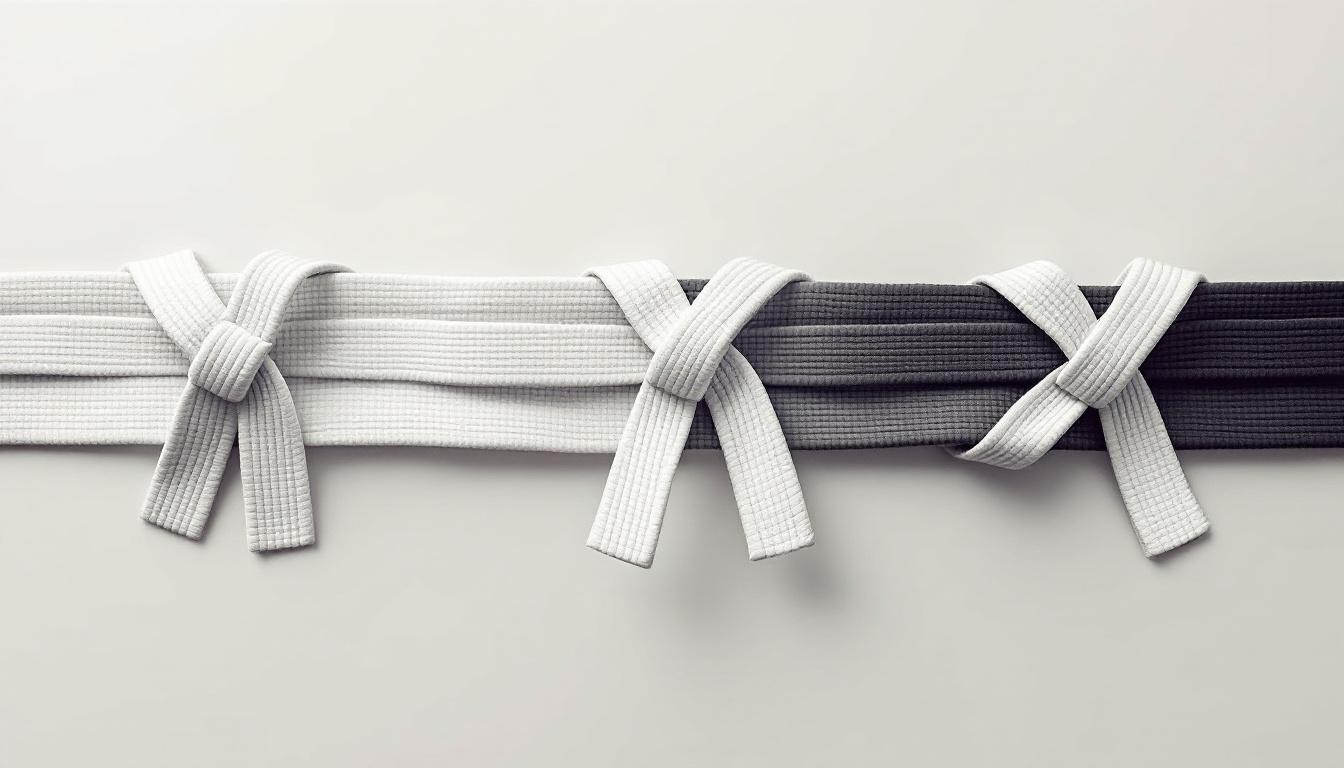At Jiu jitsu, we understand the significance of each belt in a practitioner’s journey. The Jiu Jitsu belt system represents more than just rank; it symbolizes growth, dedication, and mastery of techniques.
In this post, we’ll explore what each belt represents in BJJ progression, from the white belt’s humble beginnings to the advanced skills of a purple belt. Whether you’re just starting or well on your way, understanding these milestones can help you appreciate the path ahead.
White Belt: The Starting Point
Mastering the Basics
At Souza Grappling Co., we view the white belt as the foundation of every BJJ practitioner’s journey. It marks the beginning where enthusiasm meets humility, and the learning curve proves steep but rewarding.
White belts focus on learning fundamental techniques and positions. This includes understanding the guard, mount, and side control positions. At this stage, practitioners learn to shrimp, bridge, and perform basic sweeps. These movements form the core of BJJ and are essential for future progress.

Building Grappling Foundations
A solid foundation in grappling is important for white belts. This involves learning to control an opponent’s body, maintain balance, and use leverage effectively. White belts also start to understand the concept of pressure and how to apply it strategically.
Safety First
One of the most important lessons for white belts is the importance of tapping out. This practice ensures safety during training and helps build trust among training partners. White belts learn to recognize dangerous positions and how to protect themselves while rolling.
The Supportive Environment
At Souza Grappling Co., we provide a supportive environment for white belts to learn, make mistakes, and grow. Our experienced instructors (with years of BJJ practice) guide beginners through this initial stage, where the love for BJJ often takes root. Over time, many practitioners find that their critical thinking skills improve, allowing them to look at problems from different angles.
Transitioning to Blue Belt
As white belts progress, they begin to see the bigger picture of BJJ. They start to connect techniques, understand basic strategies, and develop a sense of flow in their movements. This gradual improvement prepares them for the next exciting stage in their BJJ journey: the blue belt.
Blue Belt: Building on the Basics
Mastering Fundamental Techniques
At Souza Grappling Co., we recognize the blue belt as a significant milestone in a practitioner’s BJJ journey. This rank demonstrates a solid grasp of fundamental techniques and the ability to execute basic submissions and escapes effectively.
Blue belts have progressed beyond the basics and now refine their techniques. They perform armbars, triangle chokes, and kimuras with increased precision. Their escapes from common positions like mount and side control become more fluid and effective. Promotion to blue belt in most large gyms is based on attendance, and practitioners can typically achieve this rank in less than two years.

Developing a Personal Style
As blue belts advance, they begin to cultivate their own unique style of BJJ. Some practitioners favor guard play, while others excel in top positions. At Souza Grappling Co., we encourage our blue belts to explore different techniques and identify what works best for their body type and strengths. This exploration proves essential for long-term growth in the sport.
Strategic Thinking and Flow
Blue belts start to comprehend the strategic elements of BJJ. They learn to chain techniques together, creating a flow in their rolling sessions. This understanding allows them to anticipate their opponent’s moves and react accordingly.
Competition and Peer Learning
At this stage, practitioners at Souza Grappling Co. receive encouragement to participate in local competitions. These experiences provide valuable insights into their strengths and areas for improvement. Many find that competition accelerates their learning and helps solidify their techniques under pressure.
Blue belts also begin to assist in teaching lower belts, which further reinforces their own knowledge. This peer-to-peer learning (a cornerstone of BJJ culture) helps create a supportive community within the gym.
As blue belts continue to progress, they face new challenges and opportunities for growth. The journey to purple belt awaits, bringing with it a deeper understanding of BJJ principles and more advanced techniques. The next stage of their journey will test their resolve and push their skills to new heights.
Purple Belt: The Intermediate Stage
Advanced Technique Refinement
At Souza Grappling Co., we consider the purple belt a significant milestone in a practitioner’s BJJ journey. This rank represents a deep understanding of techniques, an ability to innovate, and a responsibility to guide lower belts.
Purple belts at our facility focus on refining their existing techniques while expanding their repertoire with more advanced moves. They perfect the nuances of submissions, develop tighter control in dominant positions, and improve their ability to chain techniques together seamlessly.
A study by the International Brazilian Jiu-Jitsu Federation indicates that purple belts typically have 3-5 years of consistent training experience. This extensive mat time allows them to execute techniques with a higher success rate and adapt them to various situations.

Teaching and Mentoring
One key aspect of the purple belt stage is the ability to teach and explain techniques to lower belts. At Souza Grappling Co., we encourage our purple belts to take on assistant instructor roles. This reinforces their own knowledge and contributes to the growth of the BJJ community.
Purple belts teaching classes is also important because it creates more of a connected, cohesive culture in the BJJ academy.
Strategic Rolling and Competition
Purple belts develop a more strategic approach to rolling and competition. They learn to read their opponents’ movements, anticipate attacks, and set up traps. This level of strategic thinking often leads to success in competitions.
Data from the IBJJF shows that purple belt divisions in major tournaments are highly competitive (with an average of 20-30 participants per weight class). To stand out in such a competitive field, purple belts must combine technical proficiency with tactical awareness.
Deeper Understanding of BJJ Principles
At the purple belt level, practitioners gain a deeper understanding of BJJ principles and philosophy. They start to see the interconnectedness of different techniques and positions, allowing them to create more complex strategies during rolls and competitions.
This deeper understanding also extends to the mental aspects of BJJ. Purple belts often develop increased mental toughness and resilience, which serves them well both on and off the mat.
Personalized Training Approach
As purple belts progress, they begin to tailor their training to their individual strengths and weaknesses. They identify areas that need improvement and seek out specific training methods to address these areas.
This personalized approach to training (combined with their growing knowledge base) allows purple belts to make significant strides in their BJJ journey, setting the stage for future advancement to brown and black belt levels.
Final Thoughts
The Jiu-Jitsu belt system represents a practitioner’s growth, dedication, and mastery of techniques. Each rank, from white to purple belt, marks a significant milestone in a BJJ practitioner’s development. At Souza Grappling Co., we emphasize continuous learning and improvement throughout the Jiu-Jitsu belt progression.
Patience and dedication are essential virtues in the BJJ journey. Progress takes time, and each belt represents countless hours of practice, sweat, and sometimes tears. We encourage our students to embrace the process and focus on personal growth rather than rush through the ranks.
The Jiu-Jitsu belt you wear symbolizes your hard work, perseverance, and acquired skills (not just a piece of fabric). Step onto the mat, embrace the challenges, and enjoy the rewarding path of Jiu-Jitsu. Your next belt awaits, but the true victory lies in the journey itself.




